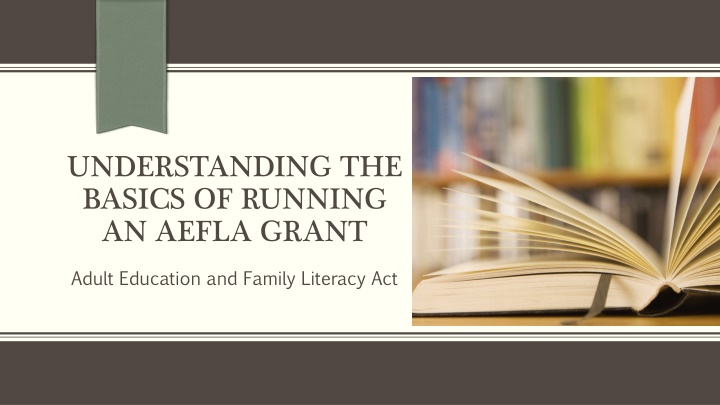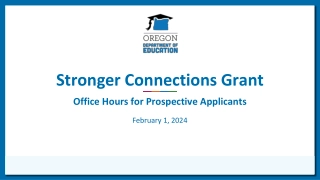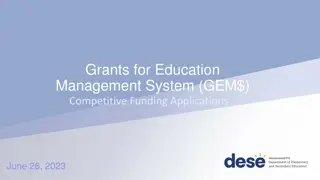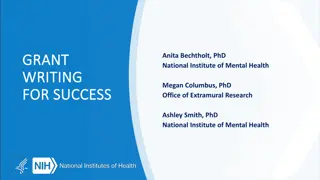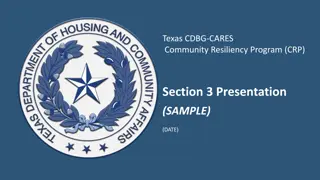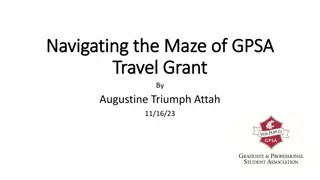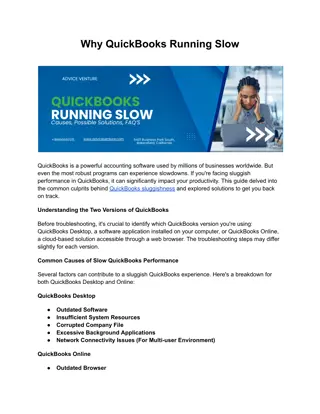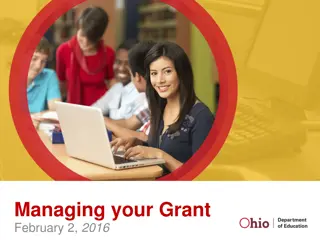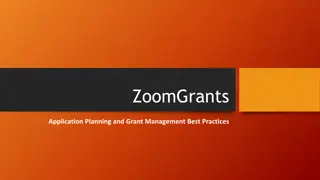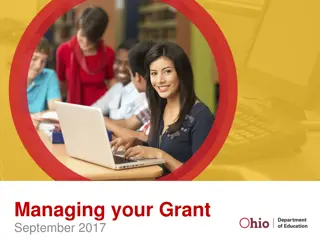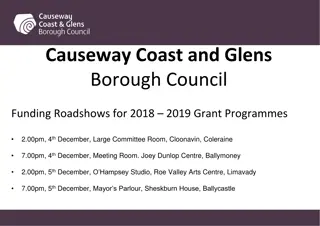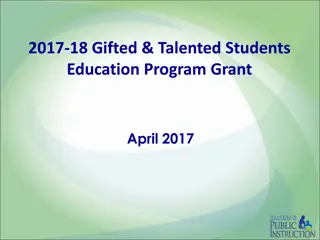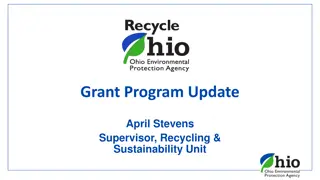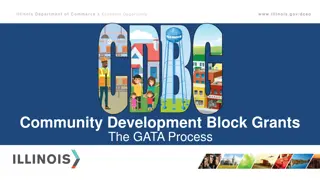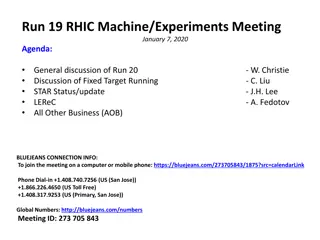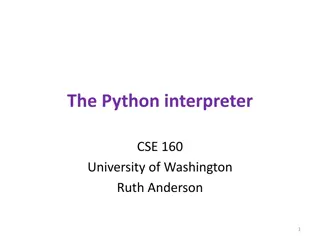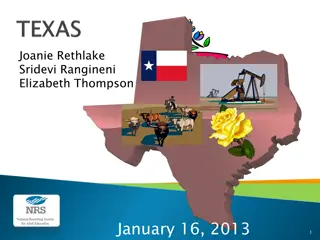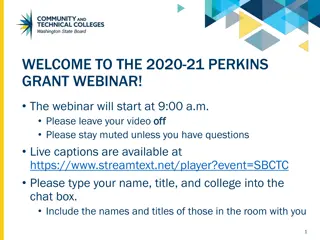Basics of Running an AEFLA Grant
Enacted on July 22, 2014, the Adult Education and Family Literacy Act (AEFLA) aims to assist adults in becoming literate, obtaining skills for employment, and supporting their children's education. The Act also focuses on helping immigrants and English language learners improve language skills and civic knowledge.
Uploaded on Mar 04, 2025 | 0 Views
Download Presentation

Please find below an Image/Link to download the presentation.
The content on the website is provided AS IS for your information and personal use only. It may not be sold, licensed, or shared on other websites without obtaining consent from the author.If you encounter any issues during the download, it is possible that the publisher has removed the file from their server.
You are allowed to download the files provided on this website for personal or commercial use, subject to the condition that they are used lawfully. All files are the property of their respective owners.
The content on the website is provided AS IS for your information and personal use only. It may not be sold, licensed, or shared on other websites without obtaining consent from the author.
E N D
Presentation Transcript
UNDERSTANDING THE BASICS OF RUNNING AN AEFLA GRANT Adult Education and Family Literacy Act
Enacted on July 22, 2014 after more than a decade to revise and reauthorize the Workforce Investment Act of 1998 Key Principles of WIOA: Encourages strategic alignment and coordination among the primary federal programs that support employment services, workforce development, adult education, and vocational rehabilitation services Seeks to ensure that job seekers receive training services that align with workforce needs Emphasis on accountability and common measures to support continuous system-wide improvements WIOA Background Fosters innovation and supports activities based on evidence-based, rigorous research, and promising practices
WIOA Administration Joint administration by the Department of Education (ED) and the Department of Labor (DOL) WIOA State Plans Performance Accountability One-Stop Delivery System Six core programs Adult, Dislocated Worker, and Youth (DOL-administered) Wagner-Peyser Employment Service (DOL-administered) AEFLA (ED-administered) Vocational Rehabilitation (ED-administered) All six core partners are administered by the Alaska Department of Labor and Workforce Development
Assist adults to become literate and obtain the knowledge and skills necessary for employment and economic self-sufficiency Title II Adult Education and Family Literacy Act (AEFLA) Assist adults who are parents or family members become a full partner in the education development of their children Assist adults in attaining a secondary school diploma and transition from adult education to postsecondary education and training through career Purposes
Assist immigrants and English language learners improve reading, writing, math, speaking, and comprehending the English language acquire understanding of American government, individual freedom, and responsibilities of citizenship Title II AEFLA Purposes (cont.)
Who is eligible? An individual who: Is 16 years of age and not enrolled or required to be enrolled in secondary school under State law Is unable to compute or solve problems, or read, write or speak English at a level necessary to function on the job, in the family, or in society Does not have a high school diploma, or Is an English language learner GED requires parent and/or guardian permission and withdrawal slip from the last school attended in Alaska
What are adult education and literacy activities? Required in the State of Alaska Required in the State of Alaska: Adult education Literacy Workplace adult education and literacy activities English language acquisition Optional, but highly recommended Optional, but highly recommended: Family literacy activities Workforce preparation activities Integrated education and training Additional grant requirements Additional grant requirements: Integrated English literacy and civics education
Academic instruction and education below the postsecondary level that increase an individual s ability to: Read, write, and speak in English and perform mathematics or other activities necessary for the attainment of a secondary school diploma or its recognized equivalent Transition to postsecondary education and training; and Obtain employment Adult Education
The term literacy individual s ability to read, write, and speak in English, compute, and solve problems, at levels of proficiency necessary to function on the job, in the family of the individual, and in society literacy means an Literacy
Workforce preparation activities include activities, programs, or services designed to help an individual acquire a combination of basic academic skills, critical thinking skills, digital literacy skills, and self- management skills, including competencies in: (a) Utilizing resources (b) Using information (c) Working with others (d) Understanding systems Workforce Preparation (e) Skills necessary for successful transition into and completion of postsecondary education or training, or employment; and (f) Other employability skills that increase an individual's preparation for the workforce
A program that is designed to help eligible individuals who are English language learners achieve competence in reading, writing, speaking, and comprehension of the English language; and That leads to Attainment of a secondary school diploma or its recognized equivalent; and Transition to postsecondary education and training; or Employment English Language Acquisition
1. How does your program meet the requirement of an English language acquisition program? 2. How does it lead to attainment of a GED? 3. How does your program transition ELL students to postsecondary education and training or employment?
OPTIONAL OPTIONAL, BUT HIGHLY RECOMMENDED ACTIVITIES
Activities that are of sufficient intensity and quality, to make sustainable improvements in the economic prospects for a family and that better enable parents or family members to support their children s learning needs, and that integrate all of the following activities: Parent or family adult education and literacy activities that lead to readiness for postsecondary education or training, career advancement, and economic self- sufficiency Interactive literacy activities between parents or family members and their children Family Literacy Training for parents or family members regarding how to be the primary teacher for their children and full partners in the education of their children An age-appropriate education to prepare children for success in school and life experiences
Adult education and literacy activities offered by an eligible provider in collaboration with an employer or employee organization at a workplace or an offsite location that is designed to improve the productivity of the workforce Workplace Adult Education and Literacy
IET refers to a service approach that provides adult education and literacy activities concurrently and contextually with workforce preparation activities and workforce training for a specific occupation or occupational cluster for the purpose of educational and career advancement Integrated Education and Training (IET)
What are the required components of an integrated education and training program funded under title II? How would your program providing IET under title II and meet the requirement that the three components be integrated?
ADDITIONAL GRANT ADDITIONAL GRANT REQUIREMENTS REQUIREMENTS
Education services provided to adult English language learners, including professionals with degrees or credentials in their native countries, that enable adults to achieve competency in the English language and acquire the basic and more advanced skills needed to function effectively as parents, workers, and citizens in the United States IELCE services must include instruction in literacy and English language acquisition, and instruction on the rights and responsibilities of citizenship and civic participation, and may include workforce training Integrated English Literacy and Civics Education (IELCE)
Integrated English Literacy and Civics Education Program (IELCE) (Section 243) States receive separate allocation under WIOA section 243 Must compete 243 funds under same provisions of WIOA section 231 Individuals who are English language learners and otherwise eligible under AEFLA are eligible under section 243, including professionals with degrees and credentials in their native countries
ELCE Program Requirements Instruction in literacy and English language acquisition and instruction on the rights and responsibilities of citizenship and civic participation; and are designed to: Prepare and place adults who are English language learners in unsubsidized employment in in-demand industries and occupations that lead to economic self-sufficiency; and Integrate with the local workforce development system Eligible provider that receives funds must use those funds to provide IELCE in combination with integrated education and training
Adult Education in Corrections Corrections education is for criminal offenders (any individual who is charged with or convicted of any criminal offense) who reside in correctional institutions. Academic programs in corrections: adult education and literacy activities special education, as determined by the eligible agency secondary school credit integrated education and training career pathways concurrent enrollment peer tutoring, and transition to re-entry initiatives and other post release services with the goal of reducing recidivism Priority of serve to individuals who are likely to leave the correctional institution within 5 years of participation in the program
WIOAS 13 CONSIDERATIONS
PARTNERSHIP WITH THE ALASKA JOB CENTER NETWORK
Access Requirements Must provide access to adult education and literacy programs and services Have staff physically present at AJC; or Have appropriately trained partner staff physically present at AJC; or Have direct linkage through technology to program staff who can provide meaningful information or services
Enter into Agreement Statewide MOU The MOU is A product of local discussion and negotiation to ensure successful integration and implementation of partner programs Used to establish the roles and responsibilities of the Local WDB, the chief elected official (CEO), and the one-stop partners in relation to the operation of the one-stop delivery system All required partners must be included in the MOU
Desk Monitoring On-Site Monitoring
Monitoring Onsite or Desk What we will be looking for . Client Files Carrying out allowable activities Financial reports Using AEFLA funds in ways that are allowable under the statute Meeting acceptable levels of performance Providing the State with data that is valid and reliable Fulfilling one-stop partner roles and responsibilities
Financial Monitoring provide fiscal control and accounting procedures to permit timely preparation of required reports permit the tracing of funds to establish that funds have been used in accordance with fund restrictions demonstrate compliance with matching requirements, cost limitations and proper classification of costs provide the proper allocation of costs by adopting consistently applied methods that reflect a reasonable relationship for cost benefit; and demonstrate compliance with insurance, procurement, property management, and other requirements referenced in the grant agreement
